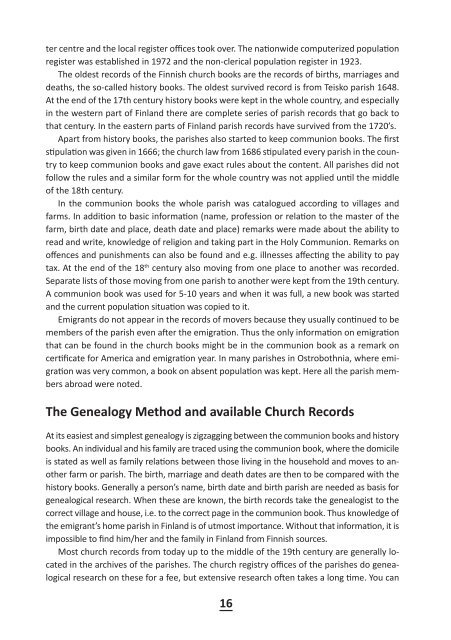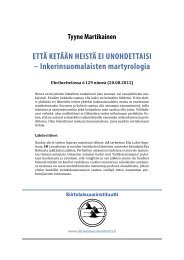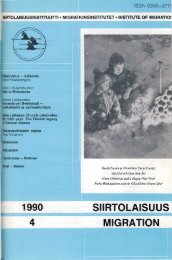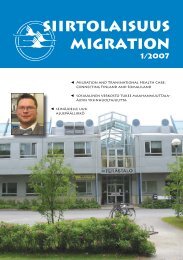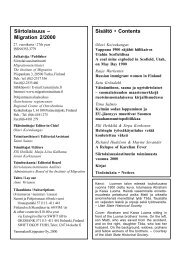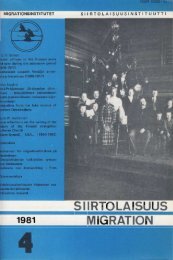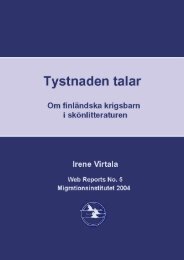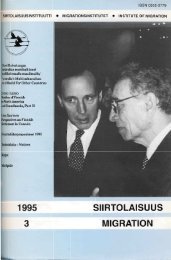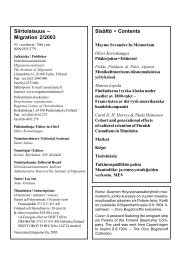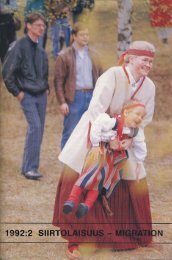How to trace your roots in Finland - Siirtolaisuusinstituutti
How to trace your roots in Finland - Siirtolaisuusinstituutti
How to trace your roots in Finland - Siirtolaisuusinstituutti
You also want an ePaper? Increase the reach of your titles
YUMPU automatically turns print PDFs into web optimized ePapers that Google loves.
ter centre and the local register offices <strong>to</strong>ok over. The nationwide computerized population<br />
register was established <strong>in</strong> 1972 and the non-clerical population register <strong>in</strong> 1923.<br />
The oldest records of the F<strong>in</strong>nish church books are the records of births, marriages and<br />
deaths, the so-called his<strong>to</strong>ry books. The oldest survived record is from Teisko parish 1648.<br />
At the end of the 17th century his<strong>to</strong>ry books were kept <strong>in</strong> the whole country, and especially<br />
<strong>in</strong> the western part of F<strong>in</strong>land there are complete series of parish records that go back <strong>to</strong><br />
that century. In the eastern parts of F<strong>in</strong>land parish records have survived from the 1720’s.<br />
Apart from his<strong>to</strong>ry books, the parishes also started <strong>to</strong> keep communion books. The first<br />
stipulation was given <strong>in</strong> 1666; the church law from 1686 stipulated every parish <strong>in</strong> the country<br />
<strong>to</strong> keep communion books and gave exact rules about the content. All parishes did not<br />
follow the rules and a similar form for the whole country was not applied until the middle<br />
of the 18th century.<br />
In the communion books the whole parish was catalogued accord<strong>in</strong>g <strong>to</strong> villages and<br />
farms. In addition <strong>to</strong> basic <strong>in</strong>formation (name, profession or relation <strong>to</strong> the master of the<br />
farm, birth date and place, death date and place) remarks were made about the ability <strong>to</strong><br />
read and write, knowledge of religion and tak<strong>in</strong>g part <strong>in</strong> the Holy Communion. Remarks on<br />
offences and punishments can also be found and e.g. illnesses affect<strong>in</strong>g the ability <strong>to</strong> pay<br />
tax. At the end of the 18 th century also mov<strong>in</strong>g from one place <strong>to</strong> another was recorded.<br />
Separate lists of those mov<strong>in</strong>g from one parish <strong>to</strong> another were kept from the 19th century.<br />
A communion book was used for 5-10 years and when it was full, a new book was started<br />
and the current population situation was copied <strong>to</strong> it.<br />
Emigrants do not appear <strong>in</strong> the records of movers because they usually cont<strong>in</strong>ued <strong>to</strong> be<br />
members of the parish even after the emigration. Thus the only <strong>in</strong>formation on emigration<br />
that can be found <strong>in</strong> the church books might be <strong>in</strong> the communion book as a remark on<br />
certificate for America and emigration year. In many parishes <strong>in</strong> Ostrobothnia, where emigration<br />
was very common, a book on absent population was kept. Here all the parish members<br />
abroad were noted.<br />
The Genealogy Method and available Church Records<br />
At its easiest and simplest genealogy is zigzagg<strong>in</strong>g between the communion books and his<strong>to</strong>ry<br />
books. An <strong>in</strong>dividual and his family are <strong>trace</strong>d us<strong>in</strong>g the communion book, where the domicile<br />
is stated as well as family relations between those liv<strong>in</strong>g <strong>in</strong> the household and moves <strong>to</strong> another<br />
farm or parish. The birth, marriage and death dates are then <strong>to</strong> be compared with the<br />
his<strong>to</strong>ry books. Generally a person’s name, birth date and birth parish are needed as basis for<br />
genealogical research. When these are known, the birth records take the genealogist <strong>to</strong> the<br />
correct village and house, i.e. <strong>to</strong> the correct page <strong>in</strong> the communion book. Thus knowledge of<br />
the emigrant’s home parish <strong>in</strong> F<strong>in</strong>land is of utmost importance. Without that <strong>in</strong>formation, it is<br />
impossible <strong>to</strong> f<strong>in</strong>d him/her and the family <strong>in</strong> F<strong>in</strong>land from F<strong>in</strong>nish sources.<br />
Most church records from <strong>to</strong>day up <strong>to</strong> the middle of the 19th century are generally located<br />
<strong>in</strong> the archives of the parishes. The church registry offices of the parishes do genealogical<br />
research on these for a fee, but extensive research often takes a long time. You can<br />
16


